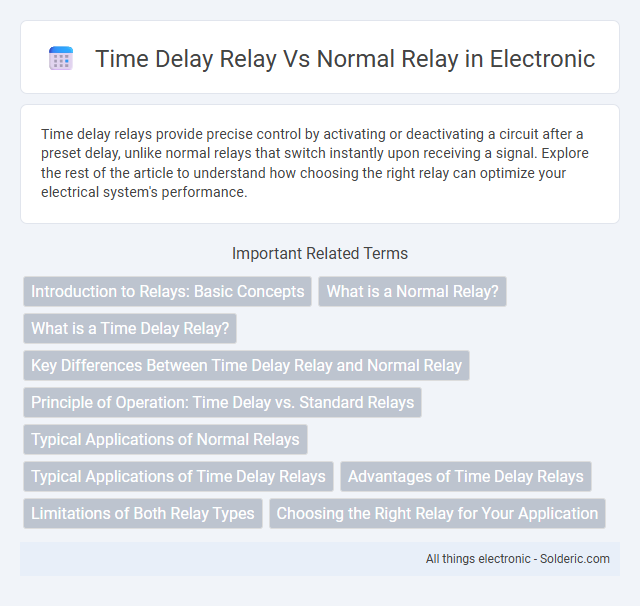Time delay relays provide precise control by activating or deactivating a circuit after a preset delay, unlike normal relays that switch instantly upon receiving a signal. Explore the rest of the article to understand how choosing the right relay can optimize your electrical system's performance.
Comparison Table
| Feature | Time Delay Relay | Normal Relay |
|---|---|---|
| Function | Activates or deactivates output after a preset time delay | Instantly activates or deactivates output when coil is energized |
| Applications | Automation, motor control, sequential operations | Switching circuits, controlling loads, signal switching |
| Operation | Built-in timer mechanism for delayed switching | Direct electromagnetic switching without delay |
| Control | Delay time adjustable via dial or programming | No timing adjustment possible |
| Cost | Generally higher due to added timer circuitry | Typically lower and simpler design |
| Complexity | More complex, suitable for timed control sequences | Simple relays for basic on/off control |
Introduction to Relays: Basic Concepts
Time delay relays differ from normal relays by incorporating a preset delay period before switching their contacts, enabling precise control over circuit timing. Normal relays operate instantaneously when energized, providing immediate switching without any intentional pause. This fundamental distinction makes time delay relays essential for applications requiring delayed activation or deactivation in electrical control systems.
What is a Normal Relay?
A normal relay is an electromechanical switch that opens or closes contacts instantly when an electrical current energizes its coil, allowing control of high-power circuits with a low-power signal. It features simple operation without built-in timing functions, making it suitable for applications requiring immediate switching response. Commonly used in automotive, industrial, and household electrical devices, normal relays provide reliable and straightforward circuit control.
What is a Time Delay Relay?
A time delay relay is an electromechanical or solid-state device designed to control the timing of electrical circuits by opening or closing contacts after a preset delay period. Unlike normal relays that switch immediately when energized, time delay relays provide precise time intervals for applications such as motor control, lighting systems, and industrial automation. Your equipment benefits from enhanced operational control and protection by incorporating time delay relays to manage start-up sequences and prevent equipment damage.
Key Differences Between Time Delay Relay and Normal Relay
Time delay relays incorporate a built-in timer to delay the activation or deactivation of the relay contacts, allowing precise control over timing functions, while normal relays switch contacts instantly upon coil energization. You benefit from enhanced automation and protection in applications requiring sequential operations or time-based control by using time delay relays. Normal relays, though simpler and faster in response, lack these timing capabilities and are typically used for basic on/off switching tasks.
Principle of Operation: Time Delay vs. Standard Relays
Time delay relays operate by incorporating an internal timer that delays the activation or deactivation of their contacts, allowing precise control over timing intervals in electrical circuits. Standard relays function by immediately switching their contacts when the coil is energized or de-energized, providing instantaneous response without any built-in delay. The time delay relay's ability to introduce adjustable delays enhances applications requiring sequential operations, while standard relays excel in scenarios demanding swift, direct switching.
Typical Applications of Normal Relays
Normal relays are commonly used in applications requiring simple on/off control, such as switching motors, controlling lights, and activating alarms. These relays provide immediate response without built-in delay, making them ideal for circuits where instant operation is essential. Your choice of normal relays is suitable for straightforward electrical control tasks without the need for timing functions.
Typical Applications of Time Delay Relays
Time delay relays are ideal for applications requiring precise control over operation timing, such as motor control circuits, HVAC systems, and lighting automation. They allow equipment to start or stop after a specific delay, ensuring protection from electrical faults and enhancing system reliability. Your industrial or home automation projects benefit from their ability to prevent mechanical wear and avoid short-cycling in compressors and pumps.
Advantages of Time Delay Relays
Time delay relays offer precise control over the timing of electrical circuits, enabling automated switching after a predetermined delay, which reduces the risk of equipment damage from sudden surges or shorts. Unlike normal relays that operate instantly, time delay relays improve system reliability by preventing false triggering and allowing safe sequential operations in industrial automation and HVAC systems. Their ability to customize delay intervals enhances energy efficiency and operational safety in complex electrical applications.
Limitations of Both Relay Types
Time delay relays face limitations in response speed and may not be suitable for applications requiring instantaneous switching, while normal relays lack timing functions, restricting their use in sequential control processes. Both types have mechanical wear issues, reducing reliability over extended periods and under high switching frequencies. Voltage and current rating constraints in both relay types limit their applicability in high-power or specialized industrial environments.
Choosing the Right Relay for Your Application
Time delay relays offer precise control by introducing adjustable delays in switching operations, making them ideal for applications requiring sequential or timed responses. Normal relays provide immediate switching without delay, suitable for simple on/off control where timing is not critical. Selecting the right relay depends on the specific needs of the system, with time delay relays preferred for processes needing timing coordination and normal relays chosen for straightforward switching tasks.
time delay relay vs normal relay Infographic

 solderic.com
solderic.com